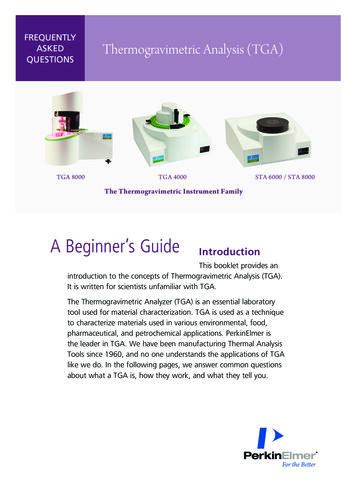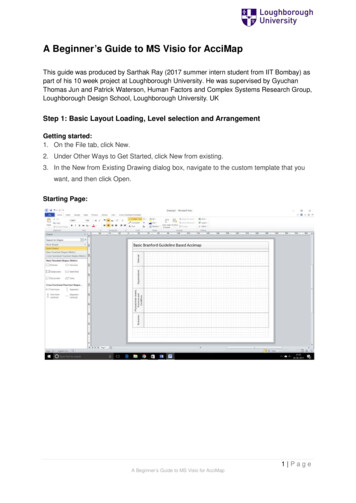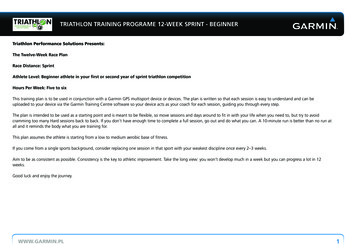
Transcription
FREQUENTLYASKEDQUESTIONSTGA 8000Thermogravimetric Analysis (TGA)TGA 4000STA 6000 / STA 8000The Thermogravimetric Instrument FamilyA Beginner’s GuideIntroductionThis booklet provides anintroduction to the concepts of Thermogravimetric Analysis (TGA).It is written for scientists unfamiliar with TGA.The Thermogravimetric Analyzer (TGA) is an essential laboratorytool used for material characterization. TGA is used as a techniqueto characterize materials used in various environmental, food,pharmaceutical, and petrochemical applications. PerkinElmer isthe leader in TGA. We have been manufacturing Thermal AnalysisTools since 1960, and no one understands the applications of TGAlike we do. In the following pages, we answer common questionsabout what a TGA is, how they work, and what they tell you.
Table of ContentsCommon Questions about TGAWhat is TGA?What is the difference between the TGA 8000 and TGA 4000?How is a TGA Thermal Curve displayed?What does a TGA Thermal Curve look like?What can we learn from this TGA Thermal Curve?What is reproducibility and why is it important?When should I check the TGA calibration?How do I clean the TGA furnace?When and how do I clean the TGA furnace tube?What is the best way to prepare a sample?What temperature range should I run in?What temperature scanning rate should I use?What do I need to know about sample atmosphere?When should I calibrate my TGA?How do I calibrate my instrument?TGA application curvesHow can the TGA be used to compare two (2) similar products?How can the TGA be used as a QA/QC tool to ensure products meettheir material specifications?How can the TGA be used to ensure product safety?Can the TGA be used to determine carbon content?Can the TGA be used to identify counterfeit products?Can the TGA be used to identify safe operating temperatures in various gases?How can the TGA be used to enhance product formulation processes?How can the TGA be used to reverse engineer a product?How can I increase my laboratory’s productivity?What should I do if I have a limited amount of sample and little time to fullycharacterize the sample?Simultaneous TGA-DSC application curveWhat is evolved gas analysis?344457778889910101112Can TGA analyze Nanomaterials?18ConclusionUseful Internet LinksASTM Plastics TGA Methods21213131414151515161617181819
Common Questions about TGAQWhat is TGA?AD efinition: Thermogravimetric Analysis is a technique in which the mass of asubstance is monitored as a function of temperature or time as the sample specimenis subjected to a controlled temperature program in a controlled atmosphere.An Alternate Definition: TGA is a technique in which, upon heating a material,its weight increases or decreases. A Simple TGA Concept to remember: TGAmeasures a sample’s weight as it is heated or cooled in a furnace.A TGA consists of a sample pan that is supported by a precision balance. That panresides in a furnace and is heated or cooled during the experiment. The mass ofthe sample is monitored during the experiment. A sample purge gas controls thesample environment. This gas may be inert or a reactive gas that flows over thesample and exits through an exhaust.PerkinElmer offers two types of TGAs, a top-loading TGA 4000 and a bottomloading or hangdown, TGA 8000 . The TGA 4000 supports the sample pan abovethe balance via a “stem” support rod. The TGA 8000 supports the sample pan viaa “hangdown” below the balance. Both styles take advantage of gravity to obtainvery accurate and reproducible measurements.TGA 4000TGA 8000These instruments can quantify loss of water, loss of solvent, loss of plasticizer,decarboxylation, pyrolysis, oxidation, decomposition, weight % filler, amount ofmetallic catalytic residue remaining on carbon nanotubes, and weight % ash.All these quantifiable applications are usually done upon heating, but there aresome experiments where information may be obtained upon cooling. Both theTGA 8000 and the TGA 4000 are controlled by PerkinElmer’s proprietary thermalsoftware, Pyris Software, and have autosampler accessories for unattended operation.Both TGAs can be used for Evolved Gas Analysis incorporated into a hyphenatedanalytical system. TGA 8000 – IR, MS or GC/MS TGA 4000 – IR or MS3
QWhat is the difference between the TGA 8000 and TGA 4000?A 4Table 1. TGA Differences.TGA 8000TGA 4000Balance TypeHangdown PanTop-Loading PanStandard FurnaceTemperature Range:Subambient to 1200 CTemperature Range:Ambient to 1000 CBalance Precision0.001%0.01%Balance Capacity1300 mg1500 mgQ How is a TGA Thermal Curve displayed?A The abscissa (X-axis) can be displayed as time or temperature and the ordinate (Y-axis)can be displayed as weight (mg) or weight percent (%).QWhat does a TGA Thermal Curve look like?AA TGA thermal curve is displayed from left to right. The descending TGA thermalcurve indicates a weight loss occurred. A 15.013 mg sample of calcium carbonatewas analyzed. Temperature Program Heat from 100 C to 900 C @ 10 C/minutein Nitrogen atmosphere with a purge rate of 20 mL/minute.
QWhat can we learn from this TGA Thermal Curve?A e must first list all pertinent information we know about the sample before we canWanalyze the data. In this case of calcium carbonate we know: CaCO3 is an irritant!; so be careful handling the sample, wear eye protection It is hygroscopic (it absorbs or attracts moisture from the air). Upon heating calcium carbonate it undergoes a reaction where bound CO2 isreleased from the material and only calcium oxide remains after the experiment.CaCO3CaO CO2Now we can fully investigate this material. The first calculation that could bedone, just to ensure the sample is pure, is to calculate the formula weight bysubstituting the atomic mass in the formula.Where:CaCO3CaO CO2Ca 40.08 atomic mass units (amu)C 12.011 amuO 15.9994 amuCa C O3(40.1) (12.0) [(16) x (3)]CaCO3100.1 (100.1) CaO CO2[(40.1) (16)] [(12.0) (16) x (2)](56.1) (44)(100.1) amuThe measured values are almost exactly equal to the calculated values. The deltaY software calculation was used to measure the “as-run” sample. So the firstcharacteristic that we learn about this sample is that it is very pure.ComponentExpected/Calculated ValuesMeasured ValueCaOCO256.1 amu44 amu55.803 amu44.102 amu5
To further characterize this calcium carbonate sample we can calculate theextrapolated onset temperature that denotes the temperature at which theweight loss begins. We use the extrapolated onset Temperature (To) becauseit is a reproducible temperature calculation and it is specified to be used byASTM , http://www.astm.org/ and ISO, http://www.iso.org.The next calculation that is useful and finalizes the characterization of calciumcarbonate is the peak calculation of the 1st derivative of the weight loss curve.The 1st derivative curve is easily displayed by selecting that option under theMATH drop-down list. The 1st derivative peak temperature (Tp) is 789.03 C.The peak of the first derivative indicates the point of greatest rate of changeon the weight loss curve. This is also known as the inflection point.6
QWhat is reproducibility and why is it important?AR eproducibility is the ability to create the same experiment over and over.Reproducibility is very important when comparing one set of data to another.If the experiment is reproduced the same each time then any variation withinthe data is due to a change in the sample; not operator error!There six (6) TGA operating variables that contribute to reproducibility: CalibrationFurnace CleanlinessSample PreparationTemperature RangeTemperature Scanning RateSample AtmosphereQWhen should I check the TGA calibration?AC alibration is easily checked. It is best to check the TGA calibration periodically.How often should this be done? As a new TGA user, it is best to check calibrationfirst each day before you begin your experiments. Once you gain an understandingof the nature of your calibration and often how it changes, you can then changethe checking interval to, for instance, every other day.If you move your instrument, then check calibration.If you shut your instrument down for a long period of time, then check calibration.QHow do I clean the TGA furnace?AT he furnace is easily cleaned by having the furnace open to air and heatingit up to 900 C and burning all organic residue off the furnace. For the TGA8000, there is a CLEAN Button on the software Instrument Control Panel. Oncedepressed, this action lowers the furnace and elevates the temperature forenough time to clean the furnace. All organic condensates will be baked off.7
QWhen and how do I clean the TGA furnace tube?AF or the TGA 8000 it is recommended to have two (2) furnace tubes if you arerunning samples that generate heavy black decomposition products that collecton the furnace tube. Having two (2) furnace tubes enables you to run the TGAwith a clean furnace tube and while you scrub the dirty furnace tube. You mayask, “When do I know if the furnace tube is affecting my analysis?” You’ll knowwhen you see a Curie point change during calibration check and the Curie pointis not within your acceptable temperature limits. Please see the HELP files for theprocedure to remove the furnace tube.To clean the furnace tube, use mild soap and water and a bottle brush to scrubthe inside of the furnace tube. If this doesn’t remove the residue, then use theappropriate solvent. When using solvents always read the MSDS and if possibleconsult with your lab safety person for any precautions. Once clean, rinse thefurnace tube with water and let it air dry.Q What is the best way to prepare a sample?AT his depends on the nature of your sample. Below are six (6) suggestions toconsider when preparing a sample. The sample size should be between 2 and 50 mg.If you have minimum amount of sample, run at least 1 mg.If possible, cover the bottom of the pan with the sample material.The sample pans, ceramic or platinum, can accommodate liquids, powders, films,solids or crystals. Once you have decided on the sample form, then for best results, use approximatelythe same sample weight during each experiment. This will ensure reproducibility. Many small pieces of sample are better than one large chunk. It is better tohave a large surface area exposed to the sample purge.8QWhat temperature range should I run in?AY ou should know your sample. You should know the approximate temperatureof the material’s transition of interest. Once you have determined the eventtemperatures, perform a survey scan. A survey scan is run at 20 C per minuteand it begins and ends 100 C below and above the transition of interest. Reviewthe survey scan and adjust the beginning and ending temperatures accordingly.Please be aware that there may be an occasion to study a material at an isothermalconstant temperature. Your TGA is capable of conducting isothermal experiments andalso cooling experiments. For cooling experiments, the scanning rates may be limited toslower rates than heating. This all depends on the temperature limits of your experiment.
QWhat temperature scanning rate should I use?AS ometimes you may want to change the temperature scanning rate. If you needbetter resolution of the transitions you should scan slower, in this case, maybechange from 20 C to 10 C per minute.If you are not concerned about the temperature transition and only want toknow inert filler content of the material, then you could scan at 50 C/minuteand decompose the polymer quickly and just calculate the remaining filler after allother components are fully decomposed. This will save time and be reproducible.QWhat do I need to know about sample atmosphere?AA t the beginning of each day always check the gas supplies to the instrument.Ensure that the purge rates are set correctly. If you are using bottled gas, thencheck how full the tank is. If it shows less than 300 psi in the tank, considerreplacing the tank. It is always best to change your purge gas before the tankruns dry. If you are using house gas, then you might consider installing a filteror a dryer or both in the gas supply line.Important: Never use pure hydrogen gas. If you are going to use a specialty gasbesides air, oxygen, argon, or nitrogen, then please check with your gas supplieror lab safety person to ensure that you are aware of all potential hazards.Many material scientists conduct oxidative studies with a TGA. This means thateither scanning or isothermal, air or oxygen is used as the sample environment. Thiscan be done by employing the oxidative gas directly from the very beginning ofthe experiment or introducing it during the experiment. Introducing an oxidativegas during an experiment is quite easy. It is done either through a Mass FlowController built into the analyzer and controlled by Pyris Software or it is introduced via an external mass flow controller that is controlled by Pyris Software.Important: For the TGA 8000 it is important to remember that the balance purgegas should always remain nitrogen, even if you are switching sample gases. Also it isimportant to always have the balance purge 10 mL/minute higher than the samplepurge. Some people run the balance purge differential, at least 10 mL/min or higherthan that. This balance gas positive purge differential prevents volatile gases fromback streaming into the balance area. The last thing you want to happen is to havevolatile residue contaminate your ultra precision balance. Never purge the balancewith reactive gases.Important: Many times oxidative studies create hydrocarbon decompositionresidue that may coat your furnace and furnace tube. Some scientists increasethe air or oxygen purge to 50 mL/minute to evacuate these containments throughthe exhaust. Please remember to increase the nitrogen balance purge also.9
QWhen should I calibrate my TGA?AT he following are reasons to check calibration: When you change the temperature range that you’ve been working in.When you change the purge gas rate.When you change the purge gas.For the TGA 8000 – when you change the hang down wire.For the TGA 4000 – when you change the sample pan holder (the stem).If the instrument is moved or re-leveled.If you feel the instrument calibration exceeds your acceptable temperature limits,then recalibrate. Typical calibration accuracy limits are within -2 C to 5 C of theexpected value. You must chose your limits based on your application.QHow do I calibrate my instrument?AY our instrument is has a series of calibration routines located in the Pyris Softwareunder Calibrate. Please read the HELP files about calibration before calibratingyour TGA.Important: always restore calibration default values before performing a newcalibration. You can tell if the calibration default values have been implementedby the date and time of each calibration routine.The calibration routines include: Restore Defaults Balance calibration – balance calibration is a self contained routine thatprompts Weight Calibration the user to empty the balance pan, zero thebalance, and place a calibration weight that is supplied with the instrument,in the sample pan. Furnace calibration – furnace calibration is a 9 point calibration that has limitsdefined by the user. All you have to do is follow the prompts input the highand low range temperature limits and depress the start calibration button.The furnace calibration is a self contained routine that completes in approximatelyfifty (50) minutes. Temperature calibration utilizes Curie point Reference Materials. Curie pointReference Materials are materials that upon heating lose their affinity formagnetism. The exact Curie point is the point where the material no longerexhibits magnetic properties. This point is located at the “End set” of theweight loss. Below is an example of a Nickel Curie Point calculation of a TGA8000 using the ONSET Calculation at the end of the weight loss.10
Temperature calibration is a self contained routine that prompts the user to introducea Curie point standard cut 3 mm in length, into the sample pan; then zero thepan and Reference Material. The software prompts you to introduce a magnetic forceto create a synthetic weight, read that weight, and then the routine conducts atemperature scan.The magnetic force is applied by placing a permanent magnet below the samplepan, for a TGA 8000 or placing the permanent magnet above the sample pan, fora TGA 4000.Because the magnet is pulling up on TGA 4000 because the permanent magnet isplaced on top of the sample, the thermal curve would be similar to the TGA 8000weight loss curve above, except the curve would be inverted indicating a weight gain.Nickel Curie Point Calculation – The Curie point is the temperature atwhich a material does not have an affinity for magnetism.TGA Application curvesMost TGA experiments use an inert sample purge gas. This is done so the sampleonly reacts to temperature during decomposition. When the sample is heated inan inert atmosphere this is called pyrolysis.Pyrolysis is the chemical decomposition of organic materials by heating in theabsence of oxygen or any other reagents.*There are times when you may want to use a reactive sample purge gas, such asoxygen. When using oxygen as a purge gas you may want to switch gases fromnitrogen to oxygen during the experiment. This is a common technique to identifythe percent carbon in a material.* http://www.reference.com/browse/pyrolysis11
12QHow can the TGA be used to compare two (2) similar products?AH ere two (2) types of coffees are compared, Zimbabwe in blue and Columbian inred, using the same method conditions. The solid lines are the weight loss curvesand the dashed lines are their respective derivatives. The differences are easilydisplayed, but it will take a coffee scientist to interpret the significance of thedifference.QHow can the TGA be used as a QA/QC tool to ensure products meettheir material specifications?AA bove is a fiberglass reinforced printed circuit board. This analysis determines theamount of resin and the amount of fiberglass used in this material. The delta Ycalculation was used to determine the component percentages. Resin 44.144%;Glass 56.854%. The resin decomposes in two steps, first rapidly, then slowsas the last remaining resin decomposes.
QHow can the TGA be used to ensure product safety?AA bove is a three (3) component material, ABS – Acrylonitrile butadiene styrene.This ABS has a high butadiene concentration. The red weight loss curve showsthree distinct weight losses representing each component. The blue derivativecurve has 3 peaks. This confirms that there are three (3) distinct thermal eventstaking place in this experiment. The percent of each component must be consistentfor this product to provide useful and safe functionality. An alternate TGA applicationis using TGA AutoStepwise analysis to examine ABS.*QCan the TGA be used to determine carbon content?AH ere is an ethyl cellulose sample; the experiment utilized gas switching. This wasdone on a TGA 4000. The sample gas purge rate was 30 mL/minute for nitrogenand air. The gas-switch from nitrogen to oxygen was triggered by a simple software command from within the sample method. The delta Y percentage after thegas switch is the carbon content of this material.* s/app–autostepwisetgaseparationabs.pdf13
14QCan the TGA be used to identify a counterfeit product?AAbove is a sample of commercial grade gypsum run in static air from 50 C to1400 C in the STA 8000 . The scanning rate was 10 C/minute. The red curveis the weight loss curve and its 1st derivative is the blue curve. The water loss of18.5% begins at the initial 50 C mark and continues evolving up to 150 C. Thevalues were calculated using the onset calculation and the delta Y calculation.QCan the TGA be used to identify safe operating temperatures invarious gases?AA bove is an example of a weight gain experiment. A manganese sample wasrun in a nitrogen atmosphere. The sample purge rate was 30 mL/minute. Thedelta Y calculation with calculation limits were arbitrarily set at 115 C and 1190 C. In this experiment the weight gain is due to the formation of manganesenitride. When manganese is run in argon, there is no weight change.
QHow can the TGA be used to enhance product formulation processes?AA bove talc sample was run in static air from 50 C to 1500 C. Scanning rate was10 C/minute. The red curve is the weight loss curve and its 1st derivative is theblue curve. Static air was used as a purge gas because talc is processed into apersonal healthcare product in that environment. A better understanding of whenthermal events occur enables a process to be optimized.QHow can the TGA be used to reverse engineer a product?AT he TGA is frequently used as a QA/QC tool. Here two products are beingcompared. Comparisons are done frequently by TGA. Many times competingproducts from different suppliers are distinguished by TGA.QHow can I increase my laboratory’s productivity?AT he TGA 8000, TGA 4000, STA 6000 and STA 8000 have optional autosamplersthat enable your instrument to run unattended.15
QAWhat should I do if I have a limited amount of sample and little timeto fully characterize the sample?T he STA 6000 and STA 8000 combines two analytical techniques (TGA and DSC).Simultaneously the STA 6000 and STA 8000 collects DSC heat flow data and TGAweight loss data. DSC Heat Flow is measured in Joules/gram and milliwatts.The STA 6000 and STA 8000 are designed with routine and research applications in mind; the STA 6000 and STA 8000 Simultaneous Thermal Analyzer applyleading edge sensor technology to yield higher accuracy and quality results. Thepatent pending SaTurnA sensor and proven compact furnace ensure better temperature control, more consistent measurements, and the fastest cool-down timethan any other simultaneous TGA-DSC analyzer.Simultaneous TGA-DSC application curveThis pharmaceutical sample was characterized by the STA 6000 and STA 8000. TheRed DSC thermal curve and the Blue TGA weight loss curve are displayed above.This sample is a free base, small-molecule crystalline powder. The DSC curveindicates that there is a crystalline melt defined by the peak temperature at228.37 C. After the melt transition, the baseline returns to a slightly lowerposition than the pre-melt baseline. This change of 1.4 mW, 19.18 mW less17.77 mW indicates that the liquid phase has a lower heat capacity (Cp) thanthe crystalline phase. The post-melt baseline changes slope as the sample beginsdecomposition. The DSC exothermic decomposition peak at 287.2 C corresponds tothe TGA extrapolated onset temperature of 287.2 C as this sample decomposes.16
Q What is evolved gas analysis?ASeveral techniques are used to analyze the gas products from a TGA experiment.This approach is called evolved gas analysis, (EGA). These are a subset of hyphenated techniques where two or more instruments are combined.The following are TGA – EGA techniques:TGA-FT-IR – A Thermogravimetric Analyzer (TGA) combined with an InfraredSpectrometer (TG-IR) is the most common type of Evolved Gas Analysis (EGA) system.When you heat a sample on the TGA, the sample will release volatile materials orgenerate combustion components as it burns. These gases are then transferredto your IR cell, where the components can be identified. This technique is mostuseful when the evolved gases are known to be one of a small set, such as water,carbon dioxide or common solvents which have characteristic IR spectra.TGA-MS – The combination of a TGA with a MS allows you to detect very lowlevels of impurities in real time. By heating a sample on the TGA, the sample willrelease volatile materials or generate combustion components as it burns. Thesegases are transferred to the MS where the components can be identified. Becauseof its ability to detect very low levels of material, the TG-MS is a powerful toolfor quality control, safety, and product development. This technique is most usefulwhen the evolved gases or breakdown products are known in advance but arefew in number.TGA-GC/MS – The combination of a TGA with a GC/MS is becoming increasinglypopular. When you heat a sample on the TGA it causes gases to be released. Thesegases are then transferred to the GC where the components can be collected. Thesample can then be run by GC to separate the material and the peaks identified by theMS. Because of its ability to detect very low levels of material in complex mixtures, theTG-GC/MS is a powerful tool for quality control, safety, and product development.TGA-FT-IRTGA-MSTGA-GC/MS17
QCan TGA analyze Nanomaterials?AT GA is widely used as a QA/QC tool in the manufacture and use of CarbonNano Tubes (CNT). TGA is used in CNT manufacturing process to characterizethe amount of metallic catalytic residue that remains on the CNT. This is donebecause CNT are classified by percent purity; in other words 100% less thepercent of catalytic residue (carbon to metal content). TGA is used to characterizeend products that contain Nanoparticles (NP) or CNTs as in their usual end productcharacterizations.Characterization of coatings on NPs and CNTs by evolved gas analysis can beachieved using TGA-EGA techniques. Both NP manufacturers and manufacturersof end products that contain NPs and CNTs use these techniques. And with TGAHyphenated systems, the TGA can always be used alone as a simple TGA.ConclusionTGA analysis is widely used to characterize and verify materials. TGA is applicableto most industries. Environmental, food science, pharmaceutical, and petrochemicalapplications are the mainstay of Thermogravimetric Analysis and Evolved Gas Analysis.Useful Internet LinksPerkinElmer Instrument es.htmPerkinElmer Corporate Websitehttp://www.perkinelmer.com/PerkinElmer Application Note Reference ral18
ASTM Plastics TGA MethodsD2288Test Method for Weight Loss of Plasticizers on HeatingD4202Test Method for Thermal Stability of PVC ResinD2115Test Method for Volatile Matter (including water) of Vinyl Chloride ResinsD2126Test Method for Response of Rigid Cellular Plastics to Thermal and Humid AgingD3045Recommended Practice for Heat Aging of Plastics Without LoadD1870Practice for Elevated Temperature Aging Using a Tubular OvenD4218Test Method for Determination of Carbon Black Content in PolyethyleneCompounds by a Muffle-FurnaceD1603Test Method for Carbon Black in Olefin PlasticsD5510Practice for Heat Aging of Oxidatively Degradable PlasticsE1131Standard Test Method for Compositional Analysis by TGAE1641Standard Test Method for Decomposition Kinetics by TGAPerkinElmer, Inc.940 Winter StreetWaltham, MA 02451 USAP: (800) 762-4000 or( 1) 203-925-4602www.perkinelmer.comFor a complete listing of our global offices, visit www.perkinelmer.com/ContactUsCopyright 2010-2015, PerkinElmer, Inc. All rights reserved. PerkinElmer is a registered trademark of PerkinElmer, Inc. All other trademarks are the property of theirrespective owners.009380C 01PKI
A Beginner’s Guide. Table of Contents. Common Questions about. TGA What is TGA? 3 What is the difference between the TGA 8000 and TGA 4000? 4 How is a TGA Thermal Curve displayed? 4 What does a TGA Thermal Curve look










